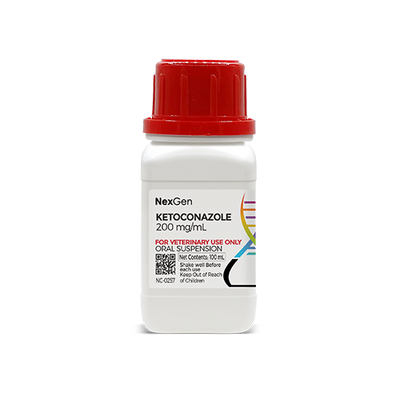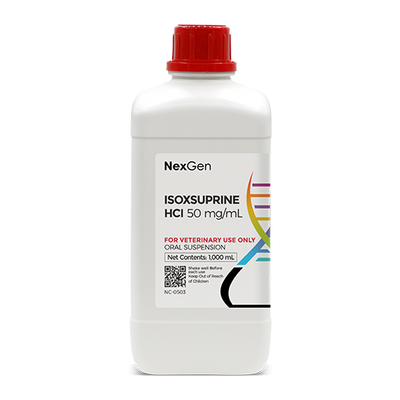
Cyproheptadine HCl 120 mg/mL, Oral Suspension, (100mL)
Login for pricing
- Brand
- Mixlab
- SKU:
- NC-0080
- Product Type:
- Suspension
- Size:
- 100ml
- Administration:
- Oral
Pituitary pars intermedia dysfunction (PPID, or Equine Cushing’s disease) is an endocrine disorder that occurs in over 20% of older horses, ponies, and donkeys.1 While most horses diagnosed with PPID are over 15 years old, this disease can occur in younger horses and equines of any breed may be affected. In cases of PPID, horses develop enlargement and tumors in the pars intermedia, a section of the pituitary gland. This gives rise to the overproduction of hormones that create an abnormal metabolic state. This potentially causes a range of problems, including:
-
Delayed shedding
-
Muscle wasting
-
Weight loss
-
Increased thirst and urination
-
Sweating or an abnormally dry coat
-
Behavior changes
-
Reproductive abnormalities
-
Infections (due to immune system suppression)1
Many horses with PPID also develop insulin dysregulation as a result of these hormonal imbalances, often developing abnormal fat deposits over the neck crest, tail head, shoulders, and around the mammary glands or prepuce. Insulin dysregulation places horses with PPID at a higher risk of developing laminitis, which can be the most devastating complication of PPID.1 Laminitis is a disease that is characterized by a weakening of the tissues (laminae) anchoring the hoof wall to the underlying bone.
Head shaking is a little-understood neuropathic condition of the horse. It is believed that this condition may affect around 1% of the equine population “to a degree of severity sufficient to require veterinary attention.”2 As a condition that gives rise to pain, it represents a significant issue. Horses are usually more severely affected when exercising; this can leave them unable to perform, or even distracted enough to be dangerous to ride or handle.
Occasional shaking of the head is a normal behavior for horses. However, when the headshaking becomes frequent, violent, accompanied by flicks or jerks of the head, accompanied by signs of nasal irritation (snorting, sneezing, rubbing the nose, etc.) then a pathological process is likely. As knowledge of this condition increased, researchers determined that this syndrome is likely due to the acquired sensitization of the trigeminal nerve, although the reason for the sensitization remains unknown.2
Cyproheptadine for Horses
As an H1-receptor antihistamine, cyproheptadine acts by competing with histamine for sites on H1-receptor sites on effector cells.4 As a class of medications, antihistamines do not block histamine release, but rather antagonize its effects. Cyproheptadine also possesses potent antiserotonin activity, in addition to anticholinergic and calcium channel blocking actions. Cyproheptadine is well-absorbed after oral administration. It is nearly completely metabolized in the liver, and these metabolites are then excreted in the urine.
The Association of Racing Commissioners International Uniform Classification Guidelines for Foreign Substances has designated cyproheptadine a CLASS 4 DRUG. As a prescription medication, U.S. federal law restricts it to use by or on the lawful written or oral order of a licensed veterinarian.
Where to buy Cyproheptadine
Cyproheptadine is available in the U.S. through several pharmaceutical manufacturers and through veterinary custom compounding companies.
FOR RX ONLY: A valid prescription from a licensed veterinarian is required for dispensing this medication.
1Schott H.C. Pituitary pars intermedia dysfunction: equine Cushing’s disease. Vet Clin North Am Equine Pract. 2002; 18: 237-270.
2Roberts V. Trigeminal-mediated headshaking in horses: prevalence, impact, and management strategies. Vet Med (Auckl). 2019;10:1-8.
4Donaldson MT, LaMonte BH, Morresey P, Smith G, Beech J. Treatment with pergolide or cyproheptadine of pituitary pars intermedia dysfunction (equine Cushing's disease). J Vet Intern Med. 2002 Nov-Dec;16(6):742-6. doi: 10.1892/0891-6640(2002)016<0742:twpoco>2.3.co;2. PMID: 12465775.




















